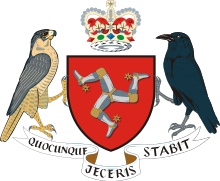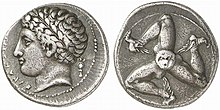Ordinaries in heraldry are sometimes embellished with stripes of colour alongside them, have lumps added to them, shown with their edges arciform instead of straight, have their peaks and tops chopped off, pushed up and down out of the usual positions, or even broken apart.
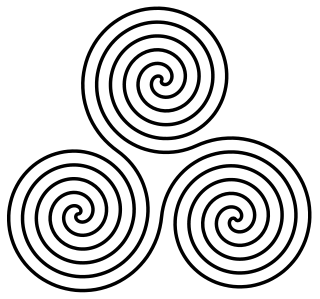
A triskelion or triskeles is an ancient motif consisting either of a triple spiral exhibiting rotational symmetry or of other patterns in triplicate that emanate from a common center. The spiral design can be based on interlocking Archimedean spirals, or represent three bent human legs. It occurs in artifacts of the European Neolithic and Bronze Ages with continuation into the Iron Age – especially in the context of the La Tène culture and of related Celtic traditions. The actual triskeles symbol of three human legs is found especially in Greek antiquity, beginning in archaic pottery and continued in coinage of the classical period.

The flag of the Isle of Man or flag of Mann is a triskelion, composed of three armoured legs with golden spurs, upon a red background. It has been the official flag of the Isle of Mann since 1 December 1932 and is based on the Manx coat of arms, which dates back to the 13th century.
Leod was the eponymous ancestor and founder of Clan MacLeod and Clan MacLeod of Lewis. Almost nothing is known about him and he does not appear in any contemporary records. Tradition dating to the late 18th century made him a son of Olaf the Black who was King of Man. Heraldic evidence, dating to the late 17th century, is considered to be the earliest evidence of descent from Olaf the Black. However, in recent years, this traditional lineage has been challenged and is no longer considered fact by one historian.
Haraldr Óláfsson was a thirteenth-century King of Mann and the Isles, and a member of the Crovan dynasty. He was one of several sons of Óláfr Guðrøðarson, King of the Isles, although the identity of his mother is uncertain. When his father died in 1237, Haraldr succeeded to the kingship as a fourteen-year-old, and held the kingship for about a decade afterwards.
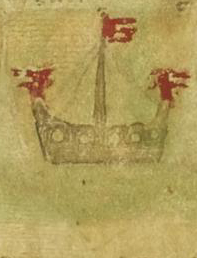
The sovereign or feudal lordship of Argyle was the holding of the senior branch of descendants of Somerled (Somhairle), this branch becoming soon known as Clan MacDougall
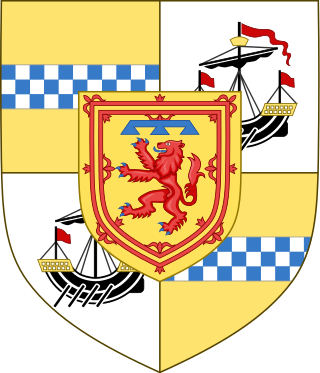
Prince and Great Steward of Scotland is one of the titles of the heir apparent to the British throne. The holder since 8 September 2022 is Prince William, who bears the other Scottish titles of Duke of Rothesay, Earl of Carrick, Lord of the Isles and Baron of Renfrew.
Godred Crovan, known in Gaelic as Gofraid Crobán, Gofraid Meránach, and Gofraid Méránach, was a Norse-Gaelic ruler of the kingdoms of Dublin and the Isles. Although his precise parentage has not completely been proven, he was certainly an Uí Ímair dynast, and a descendant of Amlaíb Cúarán, King of Northumbria and Dublin.

A roll of arms is a collection of coats of arms, usually consisting of rows of painted pictures of shields, each shield accompanied by the name of the person bearing the arms.
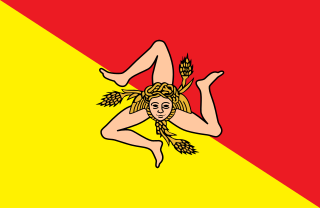
The flag of Sicily shows a triskeles symbol, and at its center a Gorgoneion and a pair of wings and three wheat ears. In the original flag, the wheat ears did not exist and the colors were reversed. The original flag was created in 1282 during the rebellion of the Sicilian Vespers.

The lion is a common charge in heraldry. It traditionally symbolises courage, nobility, royalty, strength, stateliness and valour, because historically the lion has been regarded as the "king of beasts". The lion also carries Judeo-Christian symbolism. The Lion of Judah stands in the coat of arms of Jerusalem. Similar-looking lions can be found elsewhere, such as in the coat of arms of the Swedish royal House of Bjelbo, from there in turn derived into the coat of arms of Finland, formerly belonging to Sweden.
Rǫgnvaldr Guðrøðarson ruled as King of the Isles from 1187 to 1226. He was the eldest son of Guðrøðr Óláfsson, King of Dublin and the Isles. Although the latter may have intended for his younger son, Óláfr, to succeed to the kingship, the Islesmen chose Rǫgnvaldr, who was likely Óláfr's half-brother. Rǫgnvaldr went on to rule the Kingdom of the Isles for almost forty years before losing control to Óláfr.

Guðrøðr Magnússon, also known as Godred Magnusson, was an illegitimate son of Magnús Óláfsson, King of Mann and the Isles. In 1275, whilst Mann was under Scottish overlordship, Guðrøðr led an unsuccessful revolt on the island. According to a near contemporary source, over five hundred people lost their lives in the subsequent Scottish invasion and suppression of the Manx. It is not certain whether Guðrøðr escaped the decisive defeat of the rebels at Battle of Ronaldsway with his life or if he was among the slain.

In heraldry and heraldic vexillology, a blazon is a formal description of a coat of arms, flag or similar emblem, from which the reader can reconstruct the appropriate image. The verb to blazon means to create such a description. The visual depiction of a coat of arms or flag has traditionally had considerable latitude in design, but a verbal blazon specifies the essentially distinctive elements. A coat of arms or flag is therefore primarily defined not by a picture but rather by the wording of its blazon. Blazon is also the specialized language in which a blazon is written, and, as a verb, the act of writing such a description. Blazonry is the art, craft or practice of creating a blazon. The language employed in blazonry has its own vocabulary, grammar and syntax, which becomes essential for comprehension when blazoning a complex coat of arms.
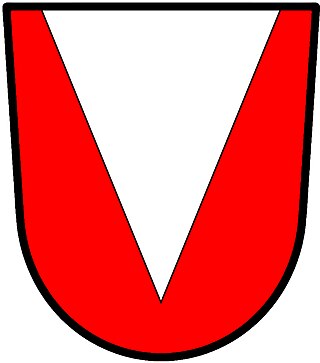
In heraldry, a pile is a charge usually counted as one of the ordinaries. It consists of a wedge emerging from the upper edge of the shield and converging to a point near the base. If it touches the base, it is blazoned throughout.
Ingimundr, also known as Ingimund, and Ingemund, was an eleventh-century delegate of Magnús Óláfsson, King of Norway. In the last decade of the eleventh century, Ingimundr was tasked by Magnús to take control of the Kingdom of the Isles. The realm had descended into utter chaos after the death of Guðrøðr Crovan, King of the Isles in 1095, which was followed by kin-strife amongst Guðrøðr's descendants, and the encroachment of Irish authority into the region. Ingimundr and his followers were slain in Lewis by the leading Islesmen whilst he was in the midst of securing the kingship. The following year, Magnús took matters into his own hands, and personally oversaw the conquest of the Isles himself.

Guðrøðr Rǫgnvaldsson, also known as Guðrøðr Dond, was a thirteenth-century ruler of the Kingdom of the Isles. He was a member of the Crovan dynasty, and a son of Rǫgnvaldr Guðrøðarson, King of the Isles, the eldest son of Guðrøðr Óláfsson, King of Dublin and the Isles. Although the latter may have intended for his younger son, Óláfr, to succeed to the kingship, the Islesmen instead settled upon Rǫgnvaldr, who went on to rule the Kingdom of the Isles for almost forty years. The bitterly disputed royal succession divided the Crovan dynasty for three generations, and played a central role in Guðrøðr's recorded life.
Rǫgnvaldr Óláfsson was a mid-thirteenth-century King of Mann and the Isles who was assassinated after a reign of less than a month. As a son of Óláfr Guðrøðarson, King of Mann and the Isles, Rǫgnvaldr Óláfsson was a member of the Crovan dynasty. When his father died in 1237, the kingship was assumed by Haraldr Óláfsson. The latter was lost at sea late in 1248, and the following year Rǫgnvaldr Óláfsson succeeded him as king.
The Spanish monarchs of the House of Habsburg and Philip V used separate versions of their royal arms as sovereigns of the Kingdom of Naples-Sicily, Sardinia and the Duchy of Milan with the arms of these territories.
Aufrica de Connoght, also known as Affrica de Counnought, Affreca de Counnoght, Auffricia de Connaught, and Aufrica de Cunnoght, was a fourteenth-century woman who claimed to be an heiress of Magnús Óláfsson, King of Mann and the Isles, and who had some sort of connection with Simon de Montagu.
